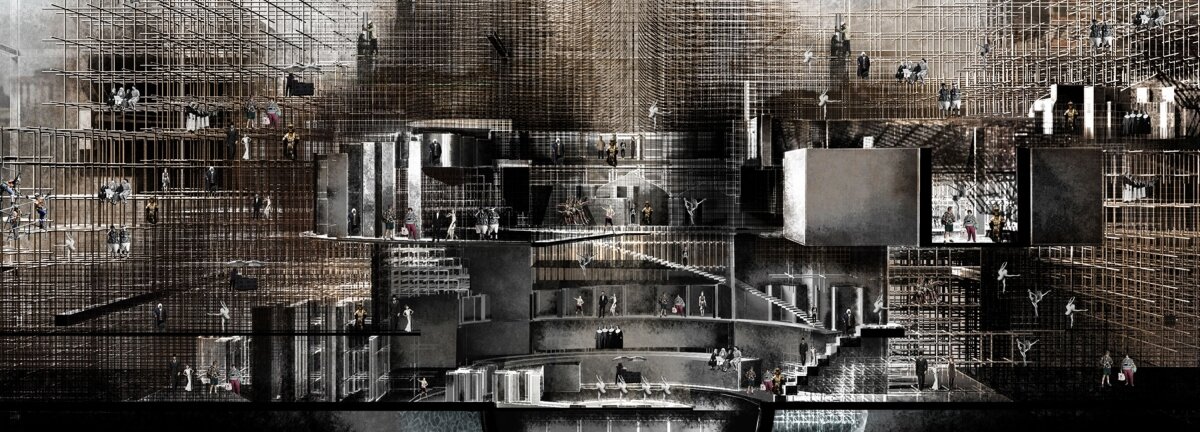Architect Paul Williams picks four Ones to Watch

We asked Paul Williams OBE, co-founder of award-winning architectural design practice Stanton Williams, to help us find four new up-and-coming designers to be part of our Ones to Watch 70th anniversary showcase.
Paul and the Royal Institute of British Architects (RIBA) team joined us here at Design Council, to look through RIBA’s previous President's Medals Student Award winners that are eligible for Ones to Watch.
We then picked the four most innovative, visionary and ambitious designers. Here's what he said about it:
Q. What did you get to see during your day scouting for us with RIBA?
A shortlist of 17 Architectural students’ projects selected from Universities in the UK. All exceptionally talented students who had previously been awarded either RIBA medals as a result of their Part 1 or Part 2 work or received high Commendations and prestigious Drawing Awards. So the benchmark was already set very high, even before we attempted to select our ‘Ones to Watch’.
Q. What was it that stood out and made you go ‘wow’?
The level of thinking, investigation and maturity shown in many of the projects was quite remarkable, considering how early many of these students are in their professional development.
The level of thinking, investigation and maturity shown in many of the projects was quite remarkable.
Q. What do you want to see more of?
Difficult to say, because each of the projects had very different agendas. Perhaps more 3D models and spatial exploration would have benefited some of the schemes, helping both the design development and the clarity of presentation.
In architecture especially, good drawing skills, although evocative and seductive, can often hide the spatial inadequacies of a scheme. The drawing itself does not solve the problem. The jury were acutely aware of this fact.
Q. How does today compare with your experience of awards as a new designer?
From a personal point of view, most of the students’ projects displayed a far stronger social agenda and awareness of environmental issues than any of the projects I was involved with as a student, so many years ago now! Of course, this broadening of horizons and a more holistic approach to problem solving, has as much to do with the demands of course programme and project brief aspirations as it does the students. But ultimately it is the students’ work ethic, inquisitiveness and unique creative approach to problem solving that sets them apart. And we definitely saw those qualities in the four students that we singled out.
High aspirations lift the spirits, and are key to improving the quality of peoples’ lives.
Q. What did you see today that could be a game changer in years to come?
Again, a difficult question to answer – other than to say that all the judges were hugely impressed by the ambition and confidence and high aspirations of the work presented. High aspirations lift the spirits, and are key to improving the quality of peoples’ lives.
Q. Why did you choose these winners?
We were asked to choose three ‘winners’, but after a lengthy debate, finally we chose four. Why exactly, it’s hard to say but probably they embodied most, if not all, the attributes mentioned in the previous questions.
They have taken on the fundamental ‘stuff’ of architecture, engaged the senses, showed a passion and empathy for their subject matter, and a real concern for people’s needs, which is one of architectures primary goals.
Kibwe Tavares
Robots of Brixton
Kibwe Tavares project included a wonderful and powerful architectural film called Robots of Brixton that explored the relationship between architecture, class and race. This insightful and visually powerful film followed ‘the trials and tribulations of young robots surviving at the sharp end of inner city life, living the predictable existence of a populous hemmed in by poverty, disillusionment and mass unemployment’. It was immediately obvious to the judges why Kibwe had previously been awarded one of the RIBA President’s Medals Student Awards.
Basmah Kaki
An Acoustic Lyrical Mechanism
Kaki described her project, An Acoustic Lyrical Mechanism, ‘like an Aeolian harp, a building played by the wind, acoustically transforming the abrasive sounds of adjacent quarrying’. Kaki’s level of maturity in thinking, investigation and execution made a huge impression on the judges.
Amy Perkins
Hampstead Garden Suburb
Perkin’s project focused on Hampstead Garden Suburb a development ‘stuck in time at a low density in a borough’ and tasked with providing 31,000 new homes in the next 10 years. The question Perkins asked was whether Barnet could start to address this ‘while recovering Henrietta Barnet’s vision of a green and spacious suburb, without pastiche or brutal shifts of scale’. Amy’s ambitious and optimistic project attempted to offer some answers and showed a really good understanding of current economic drivers affecting development today.
Vidhya Pushpanathan
The Depository of Forgotten Monuments
Set in Moscow, Vidhya’s project, The Depository of Forgotten Monuments, explored the relationship between preserved historical monuments and contemporary transplants and additions. Her proposals put forward a ‘flexible and dynamic architectural framework that took into account conflicting urban processes, structures and programmes’. The confidence and inquisitiveness that Vidhya’s project exhibited was something that helped determine this as one of the winners.
Subscribe to our newsletter
Want to keep up with the latest from the Design Council?
